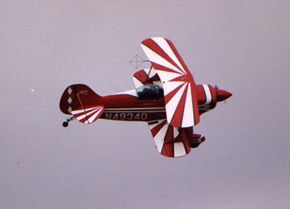Gravity is one of those amazing things -- because it is constant, we take it completely for granted. For example, the fuel system in any normal car or airplane depends on gravity to position and move the fuel in the fuel tank. A high-wing monoplane like the one shown in How Airplanes Work would stall almost immediately if you tried to fly it upside down. Gravity draws the fuel from the fuel tanks (located inside the wings) down to the engine.
So how does an aerobatic plane that flies upside down and does loops get fuel from the gas tank to the engine? To answer this question, I spoke to Randy Henson, pilot of the aerobatic biplane shown below:
Advertisement
According to Randy, there are two techniques:
"The second solution to the problem is the header tank. This is used in airplanes such as the Super Decathlon, a high-wing monoplane. In this type of plane the main fuel tanks are located in the wings, which are higher than the engine. In upright flight, the fuel has a gravity head to the suction of the engine-driven fuel pump (in planes like the Cessna 150, which does not have an inverted fuel system, you don't need a fuel pump -- the fuel is gravity-fed to the carb). For inverted flight, there is a small header tank near the pilot's feet. The header tank is connected to the main tanks in the wings; during upright flight, fuel from the wing tanks flows by gravity into the header tank until it is full. The header tank is connected to the suction side of the fuel pump -- when the plane is rolled inverted, the header tank is above the engine, and the fuel gravity flows from the header tank to the fuel pump. There is a check valve in the line connecting the main tank to the header tank; this prevents fuel from the header tank from draining back into the main tank when the plane is inverted. In the Decathlon, the header tank holds enough fuel for about two minutes of inverted flight.
"My plane and all of the more modern aerobatic planes I have seen are fuel injected. However, some of the older Pitts I have seen have a pressure carb, and it works in inverted flight. "
These links will help you learn more:
Advertisement
